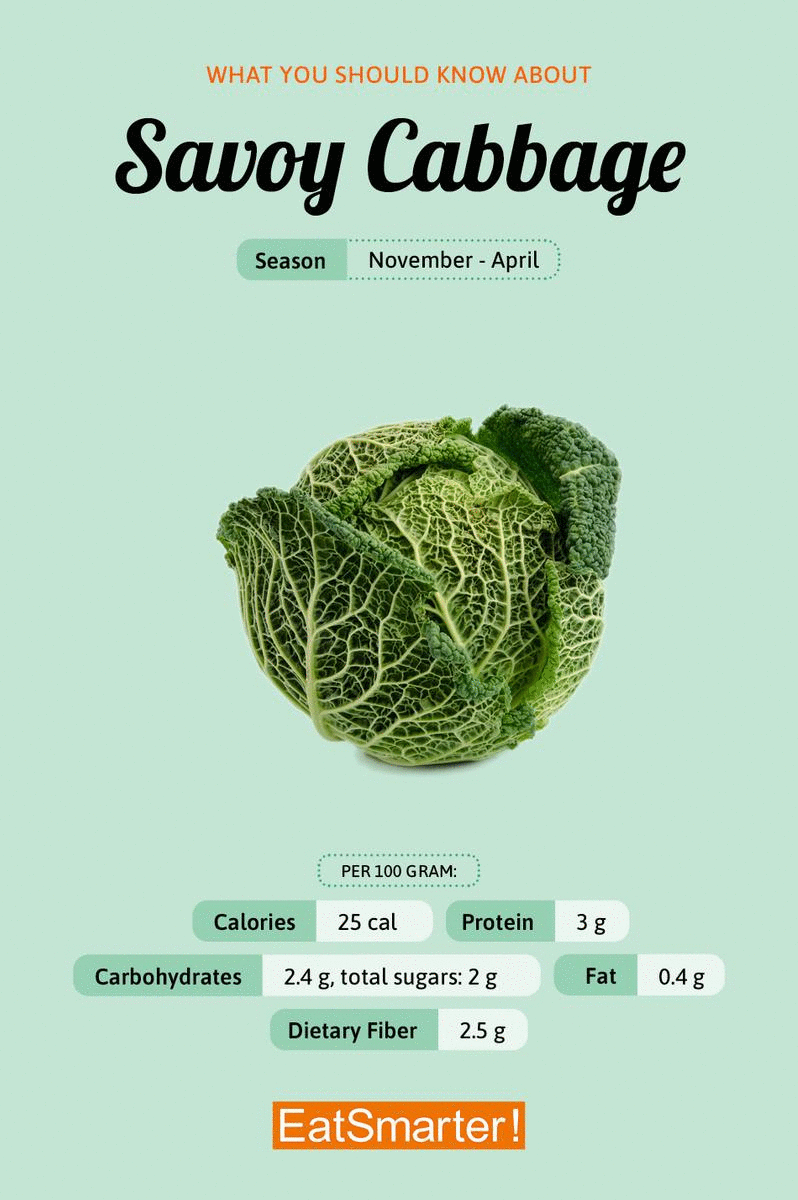Savoy Cabbage
With its flowery, veined leaves, savoy cabbage is one of the prettier cabbages, and one of the tastiest as well. In recent years its delicate taste and numerous health benefits have made it an increasingly popular vegetable for home cooks and professional chefs alike.

Savoy cabbage...
- …contains a lot of chlorophyll.Savoy cabbage’s chlorophyll content is particularly high, which gives it its green color and comes with a slew of health benefits. Among other things, chlorophyll promotes blood formation, compensates for magnesium deficiency and supports wound healing.
- ...may help prevent cancer.Savoy cabbage contains plenty of so-called glucosinolates. When these plant substances are utilised in the body, substances are produced which have been shown to prevent cancer in the stomach, breast, abdomen, liver and lungs.
- ...is a great source of vitamin C.A 100 gram serving contains half of your daily requirement of the immune-boosting nutrient.
- ...helps keep you young.Other plant substances in savoy cabbage considerably enhances the effect of chlorophyll. Various flavonoids, indole and phenols have been shown to protect the body’s cells from the harmful effects of free radicals and delay premature aging.
- ...is packed with vitamin E.100 grams of savoy cabbage contains 2.5 milligrams of vitamin E, half of the average daily requirement.
- ...should be consumed fresh.Theoretically savoy cabbage can keep for weeks in a cool place. Nevertheless, rapid consumption is recommended. The longer the savoy cabbage sits, the lower its valuable vitamin content will be.
- ...isn't for everyone.Even the tender summer savoy cabbage can cause bloating in sensitive people, and even more so with the strong winter savoy cabbage. Best prevention: season savoy cabbage with caraway, ginger or aniseed. Or drink an anise or fennel tea right after eating.
What You Should Know About Savoy Cabbage
Not so long ago, gourmands turned up their nose at savoy cabbage, which, like cabbage in general, was considered a typical lower-class meal. However recently chefs have increasingly begun to utilize savoy cabbage, which has a softer, more delicate aroma than many other cabbages. This applies to savoy cabbage in general, but especially to the light green and particularly tender young early savoy cabbage and summer savoy. Late varieties or so-called autumn and permanent savoy cabbage are much stronger in consistency, colour and aroma.
Origins
Originally from the Mediterranean savoy cabbage is now grown throughout Europe and in the United States.
Seasonality
The first savoy cabbage of the year is harvested as early as April. Early savoy cabbage and summer savoy cabbage hits the market in June, while autumn savoy cabbage begins harvest in August and lasts until February, depending on weather and region. From March to May the supply of savoy cabbage is somewhat more limited, however you can still find some varieties in most grocery stores.
Flavor
Savoy cabbage not only looks different than white and red cabbage, it also has a stronger taste than the other members of its vegetable family. This is especially true of young spring savoy cabbage, as the autumn and winter savoy cabbages also taste comparatively more subtle.
Varieties
Savoy cabbage is available in different varieties: robust winter savoy cabbage has a more spicy, intense taste and curlier, darker leaves than the tender summer savoy cabbage.
Find all our savoy cabbage recipes here.
How Healthy Is Savoy Cabbage?
Savoy cabbage is a great source of vitamin C-- a 200 gram portion already covers your daily requirement. The vegetable also contains a rich combination of nutrients and minerals, including iron, protein and magnesium, as well as vitamin A. It is also rich in folic acid, which supports cell metabolism and blood formation, and has a high vitamin B6 content, which is good for the nervous system. Savoy cabbage is also very low in fat and calories.
| Savoy Cabbage Nutritional Info (100 g) | |
|---|---|
| Calories | 25 |
| Protein | 3 g |
| Fat | 0.4 g |
| Carbohydrates | 2.4 g |
| Fiber | 2.5 g |
Shopping and Cooking Tips
Shopping
Make sure that the heads open loosely and are not too long, and that the leaves are green and fresh looking, without any yellow parts or wilting.
Storage
Fresh summer savoy cabbage stays fresh and crisp for a good two to three days in the refrigerator. The winter variety stays fresh for even longer, from one to two weeks. You can always freeze savoy cabbage as well, though this will make it slightly less flavorful and can affect the cabbage’s texture.
Preparation
Savoy cabbage is easy to prepare: simply remove the outer leaves, cut out the stalk and quarter the head. Then cut into strips and rinse briefly under running water. For savoy cabbage roulades, simply remove the leaves from the whole head and cut out the thick leaf veins in the middle.
What To Make With Savoy Cabbage
Savoy cabbage cooks quicker than most other types of cabbage: a maximum of 15 minutes is enough for young savoy cabbage, and about 25 minutes is sufficient for the winter version. Its short cooking time makes savoy cabbage perfect for fine but quick dishes such as casseroles or pastas.
Savoy cabbage also makes a great side dish. After cleaning, washing and chopping, simply cook the cabbage strips in broth or water. Sprinkle them with freshly chopped parsley, and you’ve got a great accompaniment to fried meat dishes.


















